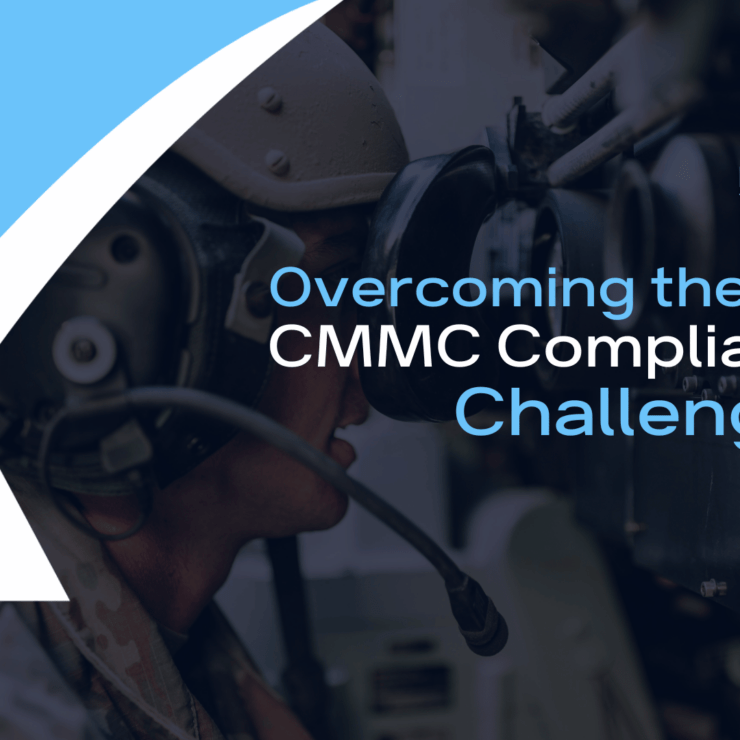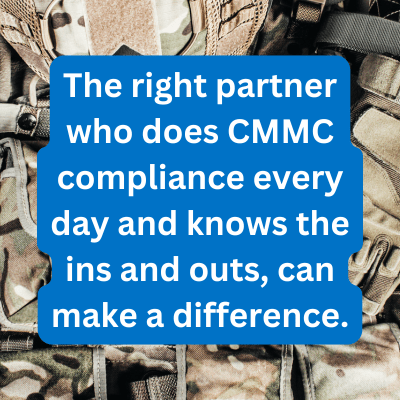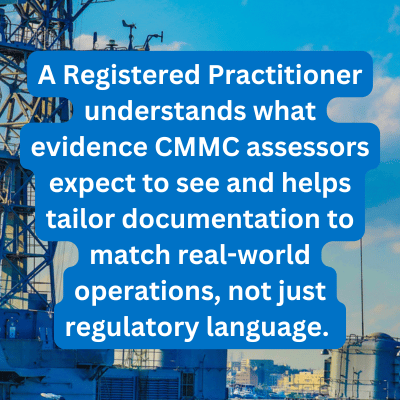Overcoming the Top CMMC Compliance Challenges

Cybersecurity Maturity Model Certification (CMMC) compliance is a must if you want to win or keep contracts with the Department of Defense (DoD). But figuring out how the requirements apply to your specific IT systems and business processes is where things can get complicated. Throw in unfamiliar terminology and layers of documentation, and it’s no wonder the process feels harder than it needs to be.
Many companies run into the same sticking points on their way to compliance. Let’s look at where things get off track and what helps companies move forward with less friction
Table of Contents
Challenge #1: Not Knowing Where to Start

The issue usually isn’t a lack of willingness to do what’s needed to comply with CMMC. It’s not knowing what to do first. Many companies begin with a contract in hand and a vague reference to CMMC requirements, but the path forward is cloudy. Who needs to be involved? What systems are affected? What’s the first step?
When you’re trying to meet compliance expectations without losing focus on what your business is actually built to do, it can seem like compliance is your second full-time job. You didn’t sign up to become a cybersecurity expert but now it feels like you have to be one just to stay in the game.
That’s where the right partner who does this every day, and knows the ins and outs of CMMC, can make a difference. You don’t need to become an expert overnight, you need someone who already is, like a CMMC Registered Practitioner (RP). An RP can guide you through every step of the CMMC process.
Learn how XPERTECHS simplifies the CMMC compliance process for companies in the DOD supply chain.
Challenge #2: Misunderstanding the Scope
One of the biggest points of confusion when you’re first starting out with CMMC is figuring out which systems, users, and processes actually need to be part of your compliance efforts. It’s easy to assume that your entire IT environment must be involved. But if certain systems or users don’t interact with the type of data covered by your contract, they might not need to be in scope at all.
Extending CMMC standards to systems and data that isn’t involved with your contract adds work, drives up costs, and creates unnecessary complexity. Once you’ve scoped too broadly, it can be difficult to backtrack without reworking your entire approach.
The key is understanding how and where Federal Contract Information (FCI) or Controlled Unclassified Information (CUI) flows through your systems. Companies that get clarity here early on can reduce their compliance footprint by limiting where CMMC needs to be applied.
Challenge #3: Confusion Around CMMC Levels
Before you can determine what security measures you need to put in place, you should understand what level of compliance your business is expected to meet. That information is typically specified in your contract or solicitation documents.
CMMC 2.0 introduced three levels of certification. Each level corresponds to the type of information your company handles, and the security requirements that go with it. Here’s a simplified breakdown:
- Level 1 is for companies handling basic Federal Contract Information (FCI). It includes 17 practices focused on basic cybersecurity hygiene.
- Level 2 applies to companies working with Controlled Unclassified Information (CUI) and includes more rigorous safeguards.
- Level 3 is reserved for contractors on the most sensitive defense projects and involves advanced security protocols and government-led assessments.
If you’re unsure what level applies, your best move is to ask your customer or contracting officer for clarification. Don’t guess. Understanding the expected level from the start will help you avoid wasted effort and missed requirements.
Related: Overview of CMMC Compliance
Challenge #4: Missing or Incomplete Documentation

CMMC compliance requires more than implementing security controls. It demands documentation that clearly shows how those controls are managed in daily operations.
Many companies invest in cybersecurity tools but fall behind on policies, procedures, and evidence needed to validate compliance. What’s more, cybersecurity practices often evolve faster than formal documentation, leaving gaps that delay certification and add unnecessary effort.
Working with a Registered Practitioner (RP) helps companies avoid common documentation gaps. An RP understands what evidence CMMC assessors expect to see and helps tailor documentation to match real-world operations, not just regulatory language. The result is that compliance efforts are aligned with how the business actually works, making it easier to maintain documentation over time and avoid last-minute scrambles when preparing for an audit.
Challenge #5: Keeping Up With a Moving Target
Meeting today’s CMMC requirements doesn’t guarantee you’ll stay compliant over time.
The CMMC Final Rule brings structure to the framework, but important details are still evolving. Currently, compliance aligns with Revision 2 of NIST 800-171 but once Revision 3 is finalized and adopted, requirements will likely shift again.
The Final Rule also formalizes new expectations: clearer standards for evidence, the introduction of annual executive affirmations, and the option for conditional certification through Plans of Action and Milestones (POA&Ms).
Keeping pace with compliance requires regular review of documentation, assessments, and regulatory updates to stay aligned with what’s required. Without someone actively tracking changes, businesses can miss updates until they become mandatory. That’s where working with a Registered Practitioner on an ongoing basis can be helpful.
Don’t Let Confusion Stall Your Progress
CMMC compliance can seem overwhelming. The truth is, most companies face the same challenges you’ve seen here and every one of them can be addressed with the right approach and support.
Whether you’re just getting started or trying to make sense of steps you’ve already taken, you don’t have to go it alone. It helps to have someone who knows the framework inside and out and can show you how to apply it to your business — without unnecessary complexity.
Why Companies Work with XPERTECHS for CMMC Compliance
XPERTECHS is a Registered Provider Organization (RPO) with Registered Practitioners (RPs) on staff. We know how to interpret the regulations and apply them in ways that make sense for your IT systems, business processes, and day-to-day operations so you can attain and maintain compliance without derailing your workflow.
Our experienced CMMC registered practitioners can help you:
- Accurately define your compliance scope
- Interpret technical requirements in plain language
- Guide you in the creation of documentation and policies
- Use cloud-based tools to collaborate and organize everything in one place
- Stay ahead of regulatory changes so you’re not caught off guard
We’ve seen firsthand how quickly things can move once you’re working with someone who knows the territory. If you’re ready to simplify your path to compliance, get in touch to schedule a consultation.
CMMC Compliance Challenges FAQs
What is the biggest challenge companies face with CMMC compliance?
Most companies struggle with knowing where to start and how to apply compliance requirements to their specific IT systems and business processes. Challenges with scoping, documentation, and keeping up with evolving requirements are also common.
How do I know what CMMC level applies to my company?
The required level is typically specified in your contract or solicitation documents. If it’s not clear, the best approach is to ask your customer or contracting officer directly for clarification.
Can I include my entire IT environment in CMMC compliance to be safe?
You can, but it’s usually unnecessary and costly. If certain systems, users, or processes don’t interact with covered data (FCI or CUI), they may not need to be in scope. Proper scoping helps reduce complexity and expense.
Why is documentation so important for CMMC compliance?
CMMC isn’t just about having security measures in place — it’s about proving those measures are managed effectively. Without documentation, it’s difficult to validate compliance during self-assessments or audits.
Are CMMC requirements going to change in the future?
Yes. While the CMMC Final Rule brings structure to the framework, details continue to evolve. The adoption of NIST 800-171 Revision 3, changes to evidence standards, and new requirements like executive affirmations mean that staying compliant requires ongoing attention.
How can a Registered Practitioner (RP) help with CMMC compliance?
An RP knows how to interpret CMMC requirements and guide companies through the process efficiently. They can help define scope, align documentation with actual business operations, and keep you prepared as requirements change.
